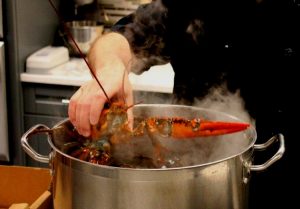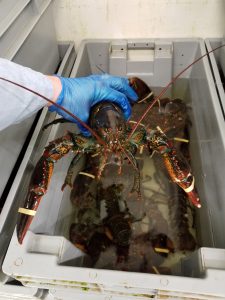Weird Lobster Facts!
 Believe it or not, some people are afraid to cook Lobster because of the terrible “scream” it lets loose in the hot pot. However, they do not have lungs or vocal cords, and thus cannot make noises. To scare predators away, some Lobsters rub their legs together to produce a crackly noise that some people compare to a sharp violin sound. But the sound the chef hears when they drop the Lobster in the pot, is most likely air escaping the shell. Lobsters are quite interesting creatures, for National Lobster Day lets learn a little more!
Believe it or not, some people are afraid to cook Lobster because of the terrible “scream” it lets loose in the hot pot. However, they do not have lungs or vocal cords, and thus cannot make noises. To scare predators away, some Lobsters rub their legs together to produce a crackly noise that some people compare to a sharp violin sound. But the sound the chef hears when they drop the Lobster in the pot, is most likely air escaping the shell. Lobsters are quite interesting creatures, for National Lobster Day lets learn a little more!
Speaking of the Lobster’s shell. Why does it turn red? We all know that Lobsters turn bright red when cooked although they start out in multiple colors. Lobsters in the wild are mostly mossy brown, but even yellow, blue, or white Lobsters exist. They turn red when cooked because the heat breaks the bond between the pigmentation and protein in the shell. The red color comes from a type of carotenoid pigment found in orange plants, eaten by the animals the Lobster eats.
 The anatomy of Lobsters is actually quite bizarre. They have two stomachs. The first of which is located behind their eyes and contains teeth-like instruments. Their kidneys are also located in their heads. Most of the abdomen is taken up by a digestive gland called the tomalley. You may have seen it referred to as the “liver,” and it turns green when cooked. Some even consider it a delicacy. The digestive gland also includes the bladder which is attached to the “nephrophores” or small openings at the base of the Lobster antennae. That’s right! Lobsters expels waste out of their faces. However, they also expel waste to attract a mate and establish dominancy during fighting.
The anatomy of Lobsters is actually quite bizarre. They have two stomachs. The first of which is located behind their eyes and contains teeth-like instruments. Their kidneys are also located in their heads. Most of the abdomen is taken up by a digestive gland called the tomalley. You may have seen it referred to as the “liver,” and it turns green when cooked. Some even consider it a delicacy. The digestive gland also includes the bladder which is attached to the “nephrophores” or small openings at the base of the Lobster antennae. That’s right! Lobsters expels waste out of their faces. However, they also expel waste to attract a mate and establish dominancy during fighting.
A Lobster’s large eyes only detect light and shadows, not colors or images. They also have extremely poor hearing, using sensory hairs to “hear” only what it can at a very close distance. They have to heavily rely on three sets of antennae for navigation, in addition to their heightened sense of smell and taste. – You’ll also find it interesting to know that they smell and taste through their legs and feet. An extremity between its eyes, called a rostrum, may look like a nose, but it’s only there to protect their eyes.
The most interesting thing about Lobsters is that when they mate, their eggs aren’t fertilized right away. The female can choose when the conditions are just right to fertilize her eggs. When lobsters mate, the male deposits his spermatozoa, and the female can hold on to it for up to two years and even seek out one or more additional males to fertilize her tens of thousands of eggs. Contrary to belief, Lobsters are not strictly monogamous. Once the Lobster fertilizes the eggs, the eggs may stay inside her for another year before she lays them. When she lays the eggs, they stay attached to her small legs under her tail, called swimmerets, for 9 to 11 months







